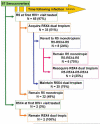Emergence and persistence of CXCR4-tropic HIV-1 in a population of men from the multicenter AIDS cohort study
- PMID: 18783316
- PMCID: PMC2753263
- DOI: 10.1086/591623
Emergence and persistence of CXCR4-tropic HIV-1 in a population of men from the multicenter AIDS cohort study
Abstract
We examined the emergence of CXCR4 (i.e., X4) tropism in 67 male human immunodeficiency virus type 1 (HIV-1) seroconverters from the Multicenter AIDS Cohort Study (MACS) who were selected to reflect the full spectrum of rates of HIV-1 disease progression. A mean of 10 serial samples per donor were evaluated by a laboratory-validated, commercially available assay to determine phenotypic coreceptor use. A total of 52% of men had dual- or mixed-tropic HIV-1 detected at 1 or more of the time points tested. Use of X4 by HIV-1 was detected more frequently among men who developed AIDS (defined as a CD4(+) T cell count of <200 cells/muL and/or an AIDS-defining illness) < or =11 years after seroconversion than among those who did not (P = .005), as well as among men who exhibited a total T cell count decline (i.e., a CD3(+) inflection point), compared with those who did not (P = .03). For men in whom both X4 virus and an inflection point were detected, emergence of X4 virus preceded the inflection point by a median of 0.83 years. The median CD4(+) T cell count at first detection of X4 viruses before the onset of AIDS was 475 cells/microL. We conclude that HIV-1 variants that used X4 frequently emerged at high CD4(+) T cell counts and may contribute to the decrease in T cell numbers during late HIV-1 infection.
Figures





Comment in
-
HIV-1 tropism, disease progression, and clinical management.J Infect Dis. 2008 Oct 15;198(8):1095-7. doi: 10.1086/591624. J Infect Dis. 2008. PMID: 18783314 No abstract available.
Similar articles
-
CD4 T cell decline following HIV seroconversion in individuals with and without CXCR4-tropic virus.J Antimicrob Chemother. 2017 Oct 1;72(10):2862-2868. doi: 10.1093/jac/dkx247. J Antimicrob Chemother. 2017. PMID: 29091208
-
The impact of HIV tropism on decreases in CD4 cell count, clinical progression, and subsequent response to a first antiretroviral therapy regimen.Clin Infect Dis. 2008 May 15;46(10):1617-23. doi: 10.1086/587660. Clin Infect Dis. 2008. PMID: 18419499
-
Purifying selection of CCR5-tropic human immunodeficiency virus type 1 variants in AIDS subjects that have developed syncytium-inducing, CXCR4-tropic viruses.J Gen Virol. 2006 May;87(Pt 5):1285-1294. doi: 10.1099/vir.0.81722-0. J Gen Virol. 2006. PMID: 16603531
-
HIV progression to AIDS: bioinformatics approach to determining the mechanism of action.Curr HIV Res. 2013 Jan;11(1):30-42. Curr HIV Res. 2013. PMID: 22998236 Review.
-
HIV-1 coreceptor usage, transmission, and disease progression.Curr HIV Res. 2003 Apr;1(2):217-27. doi: 10.2174/1570162033485357. Curr HIV Res. 2003. PMID: 15043204 Review.
Cited by
-
Impact of HIV-1 tropism on the emergence of non-AIDS events in HIV-infected patients receiving fully suppressive antiretroviral therapy.AIDS. 2016 Mar 13;30(5):731-41. doi: 10.1097/QAD.0000000000000977. AIDS. 2016. PMID: 26595543 Free PMC article.
-
Newer antiretroviral agents and how to use them.Curr HIV/AIDS Rep. 2009 May;6(2):55-62. doi: 10.1007/s11904-009-0009-9. Curr HIV/AIDS Rep. 2009. PMID: 19358775 Review.
-
Ensemble survival tree models to reveal pairwise interactions of variables with time-to-events outcomes in low-dimensional setting.Stat Appl Genet Mol Biol. 2018 Feb 17;17(1):/j/sagmb.2018.17.issue-1/sagmb-2017-0038/sagmb-2017-0038.xml. doi: 10.1515/sagmb-2017-0038. Stat Appl Genet Mol Biol. 2018. PMID: 29453930 Free PMC article.
-
HIV Co-receptor usage in HIV-related non-hodgkin's lymphoma.Infect Agent Cancer. 2012 Mar 15;7(1):6. doi: 10.1186/1750-9378-7-6. Infect Agent Cancer. 2012. PMID: 22420651 Free PMC article.
-
Variation in human β-defensin genes: new insights from a multi-population study.Int J Immunogenet. 2013 Aug;40(4):261-9. doi: 10.1111/iji.12021. Epub 2012 Nov 29. Int J Immunogenet. 2013. PMID: 23194186 Free PMC article.
References
-
- Berger EA, Murphy PM, Farber JM. Chemokine receptors as HIV-1 coreceptors: roles in viral entry, tropism, and disease. Annu Rev Immunol. 1999;17:657–700. - PubMed
-
- Koot M, Keet IP, Vos AH, et al. Prognostic value of HIV-1 syncytium-inducing phenotype for rate of CD4+ cell depletion and progression to AIDS. Ann Intern Med. 1993;118:681–8. - PubMed
-
- Maas JJ, Gange SJ, Schuitemaker H, Coutinho RA, van Leeuwen R, Margolick JB. Strong association between failure of T cell homeostasis and the syncytium-inducing phenotype among HIV-1-infected men in the Amsterdam Cohort Study. AIDS. 2000;14:1155–61. - PubMed
-
- Decrion AZ, Varin A, Estavoyer JM, Herbein G. CXCR4-mediated T cell apoptosis in human immunodeficiency virus infection. J Gen Virol. 2004;85:1471–8. - PubMed
Publication types
MeSH terms
Substances
Grants and funding
LinkOut - more resources
Full Text Sources
Other Literature Sources
Medical
Research Materials
Miscellaneous

